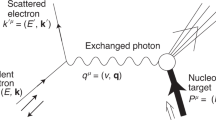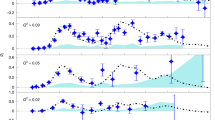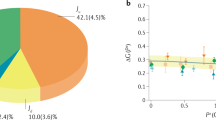Abstract
Notwithstanding decades of progress since Yukawa first developed a description of the force between nucleons in terms of meson exchange1, a full understanding of the strong interaction remains a considerable challenge in modern science. One remaining difficulty arises from the non-perturbative nature of the strong force, which leads to the phenomenon of quark confinement at distances on the order of the size of the proton. Here we show that, in relativistic heavy-ion collisions, in which quarks and gluons are set free over an extended volume, two species of produced vector (spin-1) mesons, namely ϕ and K*0, emerge with a surprising pattern of global spin alignment. In particular, the global spin alignment for ϕ is unexpectedly large, whereas that for K*0 is consistent with zero. The observed spin-alignment pattern and magnitude for ϕ cannot be explained by conventional mechanisms, whereas a model with a connection to strong force fields2,3,4,5,6, that is, an effective proxy description within the standard model and quantum chromodynamics, accommodates the current data. This connection, if fully established, will open a potential new avenue for studying the behaviour of strong force fields.
This is a preview of subscription content, access via your institution
Access options
Access Nature and 54 other Nature Portfolio journals
Get Nature+, our best-value online-access subscription
$29.99 / 30 days
cancel any time
Subscribe to this journal
Receive 51 print issues and online access
$199.00 per year
only $3.90 per issue
Buy this article
- Purchase on Springer Link
- Instant access to full article PDF
Prices may be subject to local taxes which are calculated during checkout



Similar content being viewed by others
Data availability
All raw data for this study were collected using the STAR detector at Brookhaven National Laboratory and are not available to the public. Derived data supporting the findings of this study are publicly available in the HEPData repository (https://www.hepdata.net/record/129067) or from the corresponding author on request.
Code availability
Codes to process raw data collected by the STAR detector and codes to analyse the produced data are not available to the public.
References
Yukawa, H. On the interaction of elementary particles. I. Proc. Phys. Math. Soc. Jpn. 17, 48–57 (1935).
Sheng, X.-L., Oliva, L. & Wang, Q. What can we learn from the global spin alignment of ϕ mesons in heavy-ion collisions? Phys. Rev. D 101, 096005 (2020).
Sheng, X.-L., Oliva, L. & Wang, Q. Erratum: What can we learn from the global spin alignment of ϕ mesons in heavy-ion collisions? Phys. Rev. D 105, 099903 (2022).
Sheng, X.-L., Wang, Q. & Wang, X.-N. Improved quark coalescence model for spin alignment and polarization of hadrons. Phys. Rev. D 102, 056013 (2020).
Sheng, X.-L., Oliva, L., Liang, Z.-T., Wang, Q. & Wang, X.-N. Spin alignment of vector mesons in heavy-ion collisions. Preprint at https://arxiv.org/abs/2205.15689 (2022).
Sheng, X.-L., Oliva, L., Liang, Z.-T., Wang, Q. & Wang, X.-N. Relativistic spin dynamics for vector mesons. Preprint at https://arxiv.org/abs/2206.05868 (2022).
Arsene, I. et al. Quark–gluon plasma and color glass condensate at RHIC? The perspective from the BRAHMS experiment. Nucl. Phys. A 757, 1–27 (2005).
Back, B. B. et al. The PHOBOS perspective on discoveries at RHIC. Nucl. Phys. A 757, 28–101 (2005).
Adams, J. et al. Experimental and theoretical challenges in the search for the quark–gluon plasma: the STAR Collaboration’s critical assessment of the evidence from RHIC collisions. Nucl. Phys. A 757, 102–183 (2005).
Adcox, K. et al. Formation of dense partonic matter in relativistic nucleus–nucleus collisions at RHIC: experimental evaluation by the PHENIX Collaboration. Nucl. Phys. A 757, 184–283 (2005).
Liang, Z.-T. & Wang, X.-N. Globally polarized quark-gluon plasma in noncentral A + A collisions. Phys. Rev. Lett. 94, 102301 (2005); erratum: 96, 039901(2006).
Liang, Z.-T. & Wang, X.-N. Spin alignment of vector mesons in non-central A + A collisions. Phys. Lett. B 629, 20–26 (2005).
Voloshin, S. A. Polarized secondary particles in unpolarized high energy hadron-hadron collisions? Preprint at https://arxiv.org/abs/nucl-th/0410089 (2004).
Betz, B., Gyulassy, M. & Torrieri, G. Polarization probes of vorticity in heavy ion collisions. Phys. Rev. C 76, 044901 (2007).
Becattini, F., Piccinini, F. & Rizzo, J. Angular momentum conservation in heavy ion collisions at very high energy. Phys. Rev. C 77, 024906 (2008).
Gao, J.-H. et al. Global quark polarization in noncentral A + A collisions. Phys. Rev. C 77, 044902 (2008).
Close, F. E. An Introduction to Quarks and Partons (Academic, 1979).
Adamczyk, L. et al. Global Λ hyperon polarization in nuclear collisions: evidence for the most vortical fluid. Nature 548, 62–65 (2017).
Adam, J. et al. Global polarization of Λ hyperons in Au + Au collisions at \(\sqrt{{s}_{NN}}\) = 200 GeV. Phys. Rev. C 98, 014910 (2018).
Abdallah, M. S. et al. Global Λ-hyperon polarization in Au + Au collisions at \(\sqrt{{s}_{NN}}\) = 3 GeV. Phys. Rev. C 104, L061901 (2021).
Acharya, S. et al. Global polarization of Λ and \(\bar{\Lambda }\) hyperons in Pb-Pb collisions at \(\sqrt{{s}_{NN}}\) = 2.76 and 5.02 TeV. Phys. Rev. C 101, 044611 (2020).
Kornas, F. J. Systematics in the global polarization measurements of Λ hyperons with HADES at SIS18. EPJ Web Conf. 259, 11016 (2022).
Schilling, K., Seyboth, P. & Wolf, G. E. On the analysis of vector-meson production by polarized photons. Nucl. Phys. B 15, 397–412 (1970); erratum 18, 332 (1970).
Poskanzer, A. M. & Voloshin, S. A. Methods for analyzing anisotropic flow in relativistic nuclear collisions. Phys. Rev. C 58, 1671–1678 (1998).
Yang, Y.-G., Fang, R.-H., Wang, Q. & Wang, X.-N. Quark coalescence model for polarized vector mesons and baryons. Phys. Rev. C 97, 034917 (2018).
Xia, X.-L., Li, H., Huang, X.-G. & Zhong Huang, H. Local spin alignment of vector mesons in relativistic heavy-ion collisions. Phys. Lett. B 817, 136325 (2021).
Gao, J.-H. Helicity polarization in relativistic heavy ion collisions. Phys. Rev. D 104, 076016 (2021).
Becattini, F., Csernai, L. & Wang, D. J. Λ polarization in peripheral heavy ion collisions. Phys. Rev. C 88, 034905 (2013); erratum 93, 069901 (2016).
Müller, B. & Yang, D.-L. Anomalous spin polarization from turbulent color fields. Phys. Rev. D 105, L011901 (2022).
Abelev, B. I. et al. Spin alignment measurements of the K*0(892) and ϕ(1020) vector mesons in heavy ion collisions at \(\sqrt{{s}_{NN}}\) = 200 GeV. Phys. Rev. C 77, 061902 (2008).
Anderson, M. et al. The STAR time projection chamber: a unique tool for studying high multiplicity events at RHIC. Nucl. Instrum. Methods Phys. Res. A 499, 659–678 (2003).
Llope, W. J. Multigap RPCs in the STAR experiment at RHIC. Nucl. Instrum. Methods Phys. Res. A 661, S110–S113 (2012).
Acharya, S. et al. Evidence of spin-orbital angular momentum interactions in relativistic heavy-ion collisions. Phys. Rev. Lett. 125, 012301 (2020).
Serot, B. D. & Walecka, J. D. The relativistic nuclear many body problem. Adv. Nucl. Phys. 16, 1–327 (1986).
Gasser, J. & Leutwyler, H. Chiral perturbation theory to one loop. Ann. Phys. 158, 142–210 (1984).
Shifman, M. A., Vainshtein, A. I. & Zakharov, V. I. Remarks on Higgs-boson interactions with nucleons. Phys. Lett. B 78, 443–446 (1978).
Csernai, L. P., Kapusta, J. I. & Welle, T. Λ and \(\bar{\Lambda }\) spin interaction with meson fields generated by the baryon current in high energy nuclear collisions. Phys. Rev. C 99, 021901 (2019).
Karpenko, I. & Becattini, F. Study of Λ polarization in relativistic nuclear collisions at \(\sqrt{{s}_{{\rm{NN}}}}\) 7.7–200 GeV. Eur. Phys. J. C 77, 213 (2017).
Bryan, R. & Scott, B. L. Nucleon-nucleon scattering from one-boson-exchange potentials. III. S waves included. Phys. Rev. 177, 1435–1442 (1969).
Nagels, M. M., Rijken, T. A. & de Swart, J. J. Low-energy nucleon-nucleon potential from Regge-pole theory. Phys. Rev. D 17, 768 (1978).
Walecka, J. D. A theory of highly condensed matter. Ann. Phys. 83, 491–529 (1974).
Mayer, M. G. On closed shells in nuclei. II. Phys. Rev. 75, 1969–1970 (1949).
Haxel, O., Jensen, J. H. D. & Suess, H. E. On the “magic numbers” in nuclear structure. Phys. Rev. 75, 1766 (1949).
Adler, C. et al. The RHIC zero degree calorimeters. Nucl. Instrum. Methods Phys. Res. A 470, 488–499 (2001).
Whitten, C. A. The beam-beam counter: a local polarimeter at STAR. AIP Conf. Proc. 980, 390–396 (2008).
Allgower, C. E. et al. The STAR endcap electromagnetic calorimeter. Nucl. Instrum. Methods Phys. Res. A 499, 740–750 (2003).
Tang, A. H., Tu, B. & Zhou, C. S. Practical considerations for measuring global spin alignment of vector mesons in relativistic heavy ion collisions. Phys. Rev. C 98, 044907 (2018).
Abelev, B. et al. Identified particle production, azimuthal anisotropy, and interferometry measurements in Au + Au collisions at \(\sqrt{{s}_{NN}}\) = 9.2 GeV. Phys. Rev. C 81, 024911 (2010).
Adams, J. et al. K(892)* resonance production in Au+Au and p+p collisions at \(\sqrt{{s}_{NN}}\) = 200 GeV. Phys. Rev. C 71, 064902 (2005).
Aggarwal, M. M. et al. K*0 production in Cu + Cu and Au + Au collisions at \(\sqrt{{s}_{NN}}\) = 62.4 GeV and 200 GeV. Phys. Rev. C 84, 034909 (2011).
Lan, S., Lin, Z.-W., Shi, S. & Sun, X. Effects of finite coverage on global polarization observables in heavy ion collisions. Phys. Lett. B 780, 319–324 (2018).
Fine, V. & Nevski, P. in Proc. 11th International Conference on Computing in High-Energy and Nuclear Physics 143–146 (2000).
Chen, K.-B., Liang, Z.-T., Song, Y.-K. & Wei, S.-Y. Spin alignment of vector mesons in high energy pp collisions. Phys. Rev. D 102, 034001 (2020).
Florkowski, W. & Ryblewski, R. Interpretation of Λ spin polarization measurements. Phys. Rev. C 106, 024905 (2022).
Acknowledgements
We thank the RHIC Operations Group and RCF at BNL, the NERSC Center at LBNL and the Open Science Grid Consortium for providing resources and support. This work was supported in part by the Office of Nuclear Physics within the U.S. DOE Office of Science, the U.S. National Science Foundation, National Natural Science Foundation of China, Chinese Academy of Sciences, the Ministry of Science and Technology of China and the Chinese Ministry of Education, the Higher Education Sprout Project by Ministry of Education at NCKU, the National Research Foundation of Korea, the Czech Science Foundation and Ministry of Education, Youth and Sports of the Czech Republic, the Hungarian National Research, Development and Innovation Office, New National Excellency Programme of the Hungarian Ministry of Human Capacities, Department of Atomic Energy and Department of Science and Technology of the Government of India, the National Science Centre of Poland, the Ministry of Science, Education and Sports of the Republic of Croatia, German Bundesministerium für Bildung, Wissenschaft, Forschung und Technologie (BMBF), Helmholtz Association, Ministry of Education, Culture, Sports, Science and Technology (MEXT) and Japan Society for the Promotion of Science (JSPS).
Author information
Authors and Affiliations
Consortia
Contributions
All authors contributed extensively.
Ethics declarations
Competing interests
The authors declare no competing interests.
Peer review
Peer review information
Nature thanks Andrea Dainese, Ilya Selyuzhenkov and Xin-Nian Wang for their contribution to the peer review of this work.
Additional information
Extended data
is available for this paper at https://doi.org/10.1038/s41586-022-05557-5.
Publisher’s note Springer Nature remains neutral with regard to jurisdictional claims in published maps and institutional affiliations.
Extended data figures and tables
Extended Data Fig. 1 Example of combinatorial-background-subtracted invariant-mass distributions and the extracted yields as a function of cosθ* for ϕ and K*0 mesons.
a, Example of ϕ → K+ + K− invariant-mass distributions, with combinatorial background subtracted, integrated over cosθ*. b, Example of \({{\rm{K}}}^{* 0}\,(\bar{{{\rm{K}}}^{* 0}})\to {{\rm{K}}}^{-}{{\rm{\pi }}}^{+}\,({{\rm{K}}}^{+}{{\rm{\pi }}}^{-})\) invariant-mass distributions, with combinatorial background subtracted, integrated over cosθ*. c, Extracted yields of ϕ as a function of cosθ*. d, Extracted yields of K*0 as a function of cosθ*.
Extended Data Fig. 2 Efficiency-corrected ϕ-meson yields as a function of cosθ* and corresponding fits with equation (2) in Methods.
The red stars are efficiency-corrected yields for ϕ mesons with |y| < 1.0 and 1.2 < pT < 1.8 GeV c−1, for 20–60% centrality at \(\sqrt{{s}_{{\rm{NN}}}}=27\,{\rm{GeV}}\).
Extended Data Fig. 3 Efficiency-corrected and acceptance-corrected K*0-meson yields as a function of cosθ* and corresponding fits with equation (5) in Methods.
The blue circles are efficiency-corrected and acceptance-corrected yields for K*0 mesons with |y| < 1.0 and 2.0 < pT < 2.5 GeV c−1, for 20–60% centrality at \(\sqrt{{s}_{{\rm{NN}}}}=54.4\,{\rm{GeV}}\).
Extended Data Fig. 4 ϕ-meson ρ00 obtained from first-order and second-order event planes.
The red stars (grey squares) show the ϕ-meson ρ00 as a function of beam energy, obtained with the second-order (first-order) event plane.
Extended Data Fig. 5 ϕ-meson ρ00 with respect to different quantization axes.
ϕ-meson ρ00 as a function of beam energy, for the out-of-plane direction (stars) and the in-plane direction (diamonds). Curves are fits based on theoretical calculations with a ϕ-meson field2. The corresponding Gs values obtained from the fits are shown in the legend.
Extended Data Fig. 6 ρ00 as a function of transverse momentum for ϕ for different collision energies.
The grey squares and red stars are results obtained with the first-order and second-order event planes, respectively.
Extended Data Fig. 7 ρ00 as a function of transverse momentum for K*0 for different collision energies.
The solid circles are results obtained with the second-order event plane.
Extended Data Fig. 8 ρ00 as a function of centrality for ϕ (upper panels) and K*0 (lower panels).
The solid squares and stars are results for the ϕ meson, obtained with the first-order and second-order event planes, respectively. The solid circles are results for the K*0 meson, obtained with the second-order event plane.
Extended Data Fig. 9 Global spin alignment measurement of ϕ and K*0 vector mesons in Au+Au collisions at 0–20% centrality.
The solid squares and stars are results for the ϕ meson, obtained with the first-order and second-order event planes, respectively. The solid circles are results for the K*0 meson, obtained with the second-order event plane.
Rights and permissions
Springer Nature or its licensor (e.g. a society or other partner) holds exclusive rights to this article under a publishing agreement with the author(s) or other rightsholder(s); author self-archiving of the accepted manuscript version of this article is solely governed by the terms of such publishing agreement and applicable law.
About this article
Cite this article
STAR Collaboration. Pattern of global spin alignment of ϕ and K*0 mesons in heavy-ion collisions. Nature 614, 244–248 (2023). https://doi.org/10.1038/s41586-022-05557-5
Received:
Accepted:
Published:
Issue Date:
DOI: https://doi.org/10.1038/s41586-022-05557-5
This article is cited by
-
New type of double-slit interference experiment at Fermi scale
Nuclear Science and Techniques (2023)
-
Lambda polarization at the Electron-ion collider in China
Nuclear Science and Techniques (2023)
-
Vector meson spin alignment by the strong force field
Nuclear Science and Techniques (2023)
-
Hypernuclei as a laboratory to test hyperon–nucleon interactions
Nuclear Science and Techniques (2023)
Comments
By submitting a comment you agree to abide by our Terms and Community Guidelines. If you find something abusive or that does not comply with our terms or guidelines please flag it as inappropriate.



